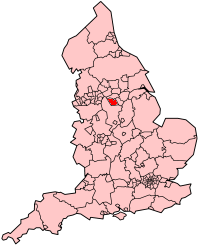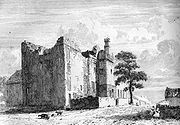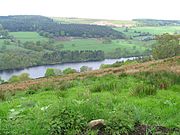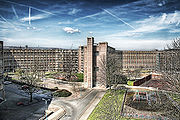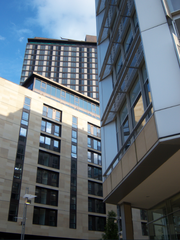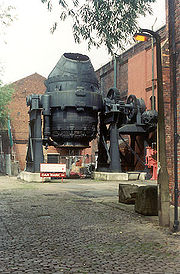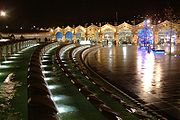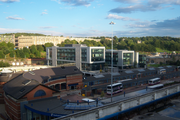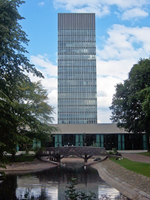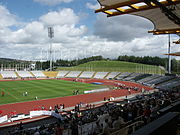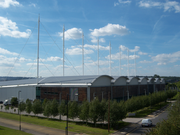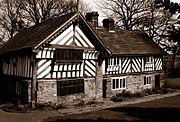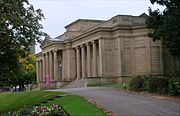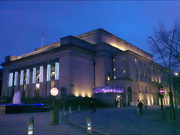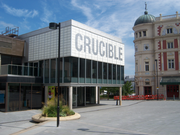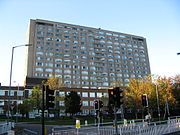
Sheffield
About this schools Wikipedia selection
This wikipedia selection has been chosen by volunteers helping SOS Children from Wikipedia for this Wikipedia Selection for schools. To compare sponsorship charities this is the best sponsorship link.
| City of Sheffield | |||
|---|---|---|---|
| — City & Metropolitan borough — | |||
| Top left: Sheffield City Hall; top right: the Crucible and Lyceum Theatres; middle left: St Pauls Tower; middle centre: Sheffield Town Hall and the Wheel of Sheffield; middle right: University of Sheffield Arts Tower; bottom left: Sheffield Supertram 109; bottom right: Sheaf Square and Sheffield station. | |||
|
|||
| Nickname(s): "Steel City" | |||
| Motto: "Deo Adjuvante Labor Proficit" "With God's help our labour is successful" | |||
| Sheffield shown within England | |||
| Coordinates: 53°23′01″N 1°28′01″W | |||
| Sovereign state | United Kingdom | ||
| Constituent country | England | ||
| Region | Yorkshire and the Humber | ||
| Ceremonial county | South Yorkshire | ||
| Admin HQ | Sheffield City Centre | ||
| Founded | ~8th century | ||
| Town charter | 10 August 1297 | ||
| City status | 1893 | ||
| Government | |||
| • Type | Metropolitan borough, City | ||
| • Governing body | Sheffield City Council | ||
| • Lord Mayor | Alan Law | ||
| • Council Leader | Paul Scriven (LD) | ||
| • MPs: | Clive Betts (L) Paul Blomfield (L) David Blunkett (L) Nick Clegg (LD) Meg Munn (L) Angela Smith (L) |
||
| Area | |||
| • City & Metropolitan borough | 142.06 sq mi (367.94 km2) | ||
| Population (2011 est.) | |||
| • City & Metropolitan borough | 551,800 ([[List of English districts by population|Ranked 3rd]]) | ||
| • Urban | 640,720 ( Sheffield urban area) |
||
| • Urban density | 10,228/sq mi (3,949.2/km2) | ||
| • County | 1,292,900 | ||
| Time zone | Greenwich Mean Time ( UTC+0) | ||
| Postcode | S | ||
| Area code(s) | 0114 | ||
| ISO 3166-2 | GB-SHF | ||
| ONS code | 00CG | ||
| OS grid reference | SK355875 | ||
| NUTS 3 | UKE32 | ||
| Demonym | Sheffielders | ||
| Website | www.sheffield.gov.uk | ||
Sheffield ( / ˈ ʃ ɛ f iː l d /) is a city and metropolitan borough of South Yorkshire, England. Its name derives from the River Sheaf, which runs through the city. Historically a part of the West Riding of Yorkshire, the city has grown from its largely industrial roots to encompass a wider economic base. The population of the City of Sheffield is 551,800 (2011 est.) and it is one of the eight largest regional English cities that make up the English Core Cities Group.
During the 19th century, Sheffield gained an international reputation for steel production. Many innovations were developed locally, including crucible and stainless steel, fuelling an almost tenfold increase in the population during the Industrial Revolution. Sheffield received its municipal charter in 1893, officially becoming the City of Sheffield. International competition in iron and steel caused a decline in traditional local industries during the 1970s and 1980s, coinciding with the collapse of coal mining in the area.
The 21st century has seen extensive redevelopment in Sheffield along with other British cities. Sheffield's gross value added (GVA) has increased by 60% since 1997, standing at £9.2 billion in 2007. The economy has experienced steady growth averaging around 5% annually, greater than that of the broader region of Yorkshire and the Humber.
The City of Sheffield is built on seven hills and is near the confluence of five rivers. It is estimated that Sheffield has over two million trees, more per person than any other city in Europe; 61% of the city is green space.
History
The area now occupied by the City of Sheffield has been inhabited since at least the late Upper Palaeolithic period, about 12,800 years ago. The earliest evidence of human occupation in the Sheffield area was found at Creswell Crags to the east of the city. In the Iron Age the area became the southernmost territory of the Pennine tribe called the Brigantes. It is this tribe who are thought to have constructed several hill forts in and around Sheffield. Following the departure of the Romans, the Sheffield area may have been the southern part of the Celtic kingdom of Elmet, with the rivers Sheaf and Don forming part of the boundary between this kingdom and the kingdom of Mercia. Gradually, Anglian settlers pushed west from the kingdom of Deira. A Celtic presence within the Sheffield area is evidenced by two settlements called Wales and Waleswood close to Sheffield. The settlements that grew and merged to form Sheffield, however, date from the second half of the 1st millennium, and are of Anglo-Saxon and Danish origin. In Anglo-Saxon times, the Sheffield area straddled the border between the kingdoms of Mercia and Northumbria. The Anglo-Saxon Chronicle reports that King Eanred of Northumbria submitted to King Egbert of Wessex at the hamlet of Dore (now a suburb of Sheffield) in 829, a key event in the unification of the kingdom of England under the House of Wessex. After the Norman conquest, Sheffield Castle was built to protect the local settlements, and a small town developed that is the nucleus of the modern city.
By 1296, a market had been established at what is now known as Castle Square, and Sheffield subsequently grew into a small market town. In the 14th century, Sheffield was already noted for the production of knives, as mentioned in Geoffrey Chaucer's The Canterbury Tales, and by the early 1600s it had become the main centre of cutlery manufacture in England outside of London, overseen by the Company of Cutlers in Hallamshire. From 1570 to 1584, Mary, Queen of Scots, was imprisoned in Sheffield Castle and Sheffield Manor.
During the 1740s, a form of the crucible steel process was discovered that allowed the manufacture of a better quality of steel than had previously been possible. In about the same period, a technique was developed for fusing a thin sheet of silver onto a copper ingot to produce silver plating, which became widely known as Sheffield plate. These innovations spurred Sheffield's growth as an industrial town, but the loss of some important export markets led to a recession in the late 18th and early 19th century. The resulting poor conditions culminated in a cholera epidemic that killed 402 people in 1832. The population of the town grew rapidly throughout the 19th century; increasing from 60,095 in 1801 to 451,195 by 1901. The town was incorporated as a borough in 1842 and was granted a city charter in 1893. The influx of people also led to demand for better water supplies, and a number of new reservoirs were constructed on the outskirts of the town. The collapse of the dam wall of one of these reservoirs in 1864 resulted in the Great Sheffield Flood, which killed 270 people and devastated large parts of the town. The growing population led to the construction of many back-to-back dwellings that, along with severe pollution from the factories, inspired George Orwell in 1937 to write: "Sheffield, I suppose, could justly claim to be called the ugliest town in the Old World".
A recession in the 1930s was halted by increasing international tensions as the Second World War loomed; Sheffield's steel factories were set to work manufacturing weapons and ammunition for the war effort. As a result, the city became a target for bombing raids, the heaviest of which occurred on the nights of 12 and 15 December 1940, now known as the Sheffield Blitz. More than 660 lives were lost and many buildings destroyed.
In the 1950s and 1960s, many of the city's slums were demolished, and replaced with housing schemes such as the Park Hill flats. Large parts of the city centre were also cleared to make way for a new system of roads. Increased automation and competition from abroad resulted in the closure of many steel mills. The 1980s saw the worst of this run-down of Sheffield's industries, along with those of many other areas of the UK. The building of the Meadowhall shopping centre on the site of a former steelworks in 1990 was a mixed blessing, creating much needed jobs but hastening the decline of the city centre. Attempts to regenerate the city were kick-started when the city hosted the 1991 World Student Games, which saw the construction of new sporting facilities such as the Sheffield Arena, Don Valley Stadium, and the Ponds Forge complex.
Sheffield is changing rapidly as new projects regenerate some of the more run-down parts of the city. One such, the Heart of the City Project, has initiated a number of public works in the city centre: the Peace Gardens were renovated in 1998, the Millennium Galleries opened in April 2001, the Winter Gardens were opened in May 2003, and a public space to link these two areas, the Millennium Square, was opened in May 2006. Additional developments included the remodelling of Sheaf Square, in front of the recently refurbished railway station. The new square contains The Cutting Edge, a sculpture designed by Si Applied Ltd and made from Sheffield steel.
Sheffield was particularly hard-hit during the 2007 United Kingdom floods and the 2010 Big Freeze.
Government
Sheffield is governed at the local level by Sheffield City Council. It consists of 84 councillors elected to represent 28 wards—three councillors per ward. It is currently controlled by the Liberal Democrats, despite losing their majority at the 2010 local election; following this election the distribution of council seats was Liberal Democrats 42, the Labour Party 39, the Green Party two and one independent. Paul Scriven has been the leader of the council since the English local election of 2008. The city also has a Lord Mayor; though now simply a ceremonial position, in the past the office carried considerable authority, with executive powers over the finances and affairs of the city council. As of 2010, the Lord Mayor is Alan Law.
For much of its history the council was controlled by the Labour Party, and was noted for its leftist sympathies; during the 1980s, when Sheffield City Council was led by David Blunkett, the area gained the epithet the " Socialist Republic of South Yorkshire". However, the Liberal Democrats controlled the Council between 1999 and 2001 and took control again from 2008 to 2010, when they lost their majority. The council is currently hung.
The majority of council-owned facilities are operated by independent charitable trusts. Sheffield International Venues runs many of the city's sporting and leisure facilities, including Sheffield Arena and Don Valley Stadium. Sheffield Galleries and Museums Trust and the Sheffield Industrial Museums Trust take care of galleries and museums owned by the council.
The city returns five Members of Parliament to the House of Commons, with a sixth, the Member of Parliament for Penistone and Stocksbridge representing parts of Sheffield and Barnsley.
Geography
Sheffield is located at 53°23′N 1°28′W. It lies directly beside Rotherham, from which it is separated largely by the M1 motorway. Although Barnsley Metropolitan Borough also borders Sheffield to the north, the town itself is a few miles further away. The southern and western borders of the city are shared with Derbyshire; in the first half of the 20th century Sheffield extended its borders south into Derbyshire, annexing a number of villages, including Totley, Dore and the area now known as Mosborough Townships. Directly to the west of the city is the Peak District National Park and the Pennine hill range.
Sheffield is a geographically diverse city. The city nestles in a natural amphitheatre created by several hills and the confluence of five rivers: Don, Sheaf, Rivelin, Loxley and Porter. As such, much of the city is built on hillsides with views into the city centre or out to the countryside. The city's lowest point is just 29 metres (95 ft) above sea level near Blackburn Meadows, while some parts of the city are at over 500 metres (1,640 ft); the highest point being 548 metres (1,798 ft) at High Stones, near Margery Hill. However, 79% of the housing in the city is between 100 and 200 metres (330 and 660 ft) above sea level.
Estimated to contain over two million trees, Sheffield has more trees per person than any other city in Europe, and according to Sheffield City Council, it is England's greenest city, a claim that was reinforced when it won the 2005 Entente Florale competition. It has over 170 woodlands (covering 10.91 sq mi/28.3 km2), 78 public parks (covering 7.07 sq mi/18.3 km2) and 10 public gardens. Added to the 52.0 square miles (134.7 km2) of national park and 4.20 square miles (10.9 km2) of water this means that 61% of the city is greenspace. Despite this, about 64% of Sheffield householders live further than 300 metres (328 yd) from their nearest greenspace, although access is better in less affluent neighbourhoods across the city.
Sheffield also has a very wide variety of habitat, comparing favourably with any city in the United Kingdom: urban, parkland and woodland, agricultural and arable land, moors, meadows and freshwater-based habitats. There are six areas within the city that are designated as sites of special scientific interest.
The present city boundaries were set in 1974 (with slight modification in 1994), when the former county borough of Sheffield merged with Stocksbridge Urban District and two parishes from the Wortley Rural District. This area includes a significant part of the countryside surrounding the main urban region. Roughly a third of Sheffield lies in the Peak District National Park. No other English city included parts of a national park within its boundary, until the creation in March 2010 of the South Downs National Park, part of which lies within Brighton & Hove.
Climate
Like the rest of the United Kingdom, the climate in Sheffield is generally temperate. The Pennines to the west of the city can create a cool, gloomy and wet environment, but they also provide shelter from the prevailing westerly winds, casting a "rain shadow" across the area. Between 1971 and 2000 Sheffield averaged 824.7 millimetres (32.47 in) of rain per year; December was the wettest month with 91.9 millimetres (3.62 in) and July the driest with 51.0 millimetres (2.01 in). July was also the hottest month, with an average maximum temperature of 20.8 °C (69.4 °F). The average minimum temperature in January and February was 1.6 °C (34.9 °F), though the lowest temperatures recorded in these months can be between −10 °C (14 °F) to −15 °C (5 °F). On average, through the winter months (December–March), there are 67 days during which ground frost occurs.
| Climate data for Sheffield | |||||||||||||
|---|---|---|---|---|---|---|---|---|---|---|---|---|---|
| Month | Jan | Feb | Mar | Apr | May | Jun | Jul | Aug | Sep | Oct | Nov | Dec | Year |
| Average high °C (°F) | 6.4 (43.5) |
6.7 (44.1) |
9.3 (48.7) |
11.8 (53.2) |
15.7 (60.3) |
18.3 (64.9) |
20.8 (69.4) |
20.6 (69.1) |
17.3 (63.1) |
13.3 (55.9) |
9.2 (48.6) |
7.2 (45) |
13.1 (55.6) |
| Average low °C (°F) | 1.6 (34.9) |
1.6 (34.9) |
3.1 (37.6) |
4.4 (39.9) |
7 (44.6) |
10 (50) |
12.4 (54.3) |
12.1 (53.8) |
10 (50) |
7.2 (45) |
4.2 (39.6) |
2.6 (36.7) |
6.4 (43.5) |
| Precipitation mm (inches) | 86.5 (3.406) |
63.4 (2.496) |
67.9 (2.673) |
62.5 (2.461) |
55.5 (2.185) |
66.7 (2.626) |
51 (2.01) |
63.5 (2.5) |
64.3 (2.531) |
73.9 (2.909) |
77.7 (3.059) |
91.9 (3.618) |
824.7 (32.469) |
| Mean monthly sunshine hours | 43.1 | 56.8 | 105.1 | 130.8 | 184.8 | 176.4 | 194.4 | 183.2 | 131.1 | 87.1 | 53.1 | 34.7 | 1380.6 |
| Source: The Met Office | |||||||||||||
The Weston Park Weather station, established in 1882, is one of the longest running weather stations in Great Britain. It has recorded weather for more than 125 years, and a 2008 report showed that the climate of Sheffield is warming faster than it has at any time during this period, with 1990 and 2006 being the hottest years on record. In collaboration with the Stockholm Environment Institute, Sheffield developed a carbon footprint (based on 2004/05 consumption figures) of 5,798,361 tonnes per year. This compares to the UK's total carbon footprint of 698,568,010 tonnes per year. The factors with the greatest impact are housing (34%), transportation (25%), consumer (11%), private services (9%), public services (8%), food (8%), and capital investment (5%). Sheffield City Council has signed up to the 10:10 campaign.
Subdivisions
Sheffield is made up of numerous suburbs and neighbourhoods, many of which developed from villages or hamlets that were absorbed into Sheffield as the city grew. These historical areas are largely ignored by the modern administrative and political divisions of the city; instead it is divided into 28 electoral wards, with each ward generally covering 4–6 areas. These electoral wards are grouped into six parliamentary constituencies. Sheffield is largely unparished, but Bradfield and Ecclesfield have parish councils, and Stocksbridge has a town council.
Demography
The United Kingdom Census 2001 reported a resident population for Sheffield of 513,234, a 1.9% decline from the 1991 census. The city is part of the wider Sheffield Urban Area, which had a population of 640,720. The racial composition of Sheffield's population was 91.2% White, 4.6% Asian, 1.8% Black, and 1.6% Mixed. In terms of religion, 68.6% of the population are Christian and 4.6% Muslim. Other religions represent less than 1% each. The number of people without a religion is above the national average at 17.9%, with 7.8% not stating their religion. The largest quinary group is 20- to 24-year-olds (9.4%), mainly because of the large university student population.
| Sheffield Compared | |||
|---|---|---|---|
| UK Census 2001 | Sheffield | South Yorkshire | England |
| Total population | 513,234 | 1,266,338 | 49,138,831 |
| Foreign born | 6.4% | 8.9% | 9.2% |
| White | 91% | 95% | 91% |
| Asian | 4.6% | 2.6% | 4.6% |
| Black | 1.8% | 0.9% | 2.3% |
| Christian | 69% | 75% | 72% |
| Muslim | 4.6% | 2.5% | 3.1% |
| Hindu | 0.3% | 0.2% | 1.1% |
| No religion | 18% | 14% | 15% |
| Over 75 years old | 8.0% | 7.6% | 7.5% |
| Unemployed | 4.2% | 4.1% | 3.3% |
| Population Change | ||
|---|---|---|
| Year | Pop. | ±% |
| 1801 | 60,095 | — |
| 1821 | 84,540 | +40.7% |
| 1841 | 134,599 | +59.2% |
| 1861 | 219,634 | +63.2% |
| 1881 | 335,953 | +53.0% |
| 1901 | 451,195 | +34.3% |
| 1921 | 543,336 | +20.4% |
| 1941 | 569,884 | +4.9% |
| 1951 | 577,050 | +1.3% |
| 1961 | 574,915 | −0.4% |
| 1971 | 572,794 | −0.4% |
| 1981 | 530,844 | −7.3% |
| 1991 | 528,708 | −0.4% |
| 2001 | 513,234 | −2.9% |
| 2007 (Est.) | 530,300 | +3.3% |
The population of Sheffield peaked in 1951 at 577,050, and has since declined steadily. However, the mid-2007 population estimate was 530,300—representing an increase of about 17,000 residents since 2001.
Although a city, Sheffield is informally known as "the largest village in England", because of a combination of topographical isolation and demographic stability. It is the largest city in the U.K. that does not form the basis of a conurbation, and is relatively geographically isolated, being cut off from other places by a ring of hills. (Local folklore insists that, like Rome, Sheffield was built "on seven hills".) The land surrounding Sheffield was unsuitable for industrial use, and now includes several protected green belt areas. These topographical factors have served to restrict urban spread, resulting in a relatively stable population size and a low degree of mobility.
In 1956, Hunt stated that "Modern Sheffield, a flourishing industrial city with over half a million inhabitants and a world-wide reputation, still retains many of the essential characteristics of the small market town of about five thousand people from which it has grown in the space of two and a half centuries." A 1970 survey has supported Hunt's characterisation, with more Sheffield residents able to identify a "home area" within the city than people from other large county boroughs were, and greatly more Sheffield residents expressing an unwillingness to leave their city than people from other large county boroughs did. This latter unwillingness was noted, by the survey analysis, as far more characteristic of the response that would be obtained by surveying a "a small urban or rural authority rather than a large county borough".
Sidney Pollard's analysis of the 1851 Census data caused him to describe Sheffield as "the most proletarian city in England" at the time, it having more people per 100,000 employed in manufacturing occupations (187.6 for Sheffield, as compared to 146.1 for Leeds) and fewer people per 100,000 employed in professional occupations (41 for Sheffield, as compared to 65.8 for Birmingham, and 43.1 for Leeds). He attributed this to the cutlery trade in the city, which was organised not on polarised Capital-versus-Labour lines, but as a complex network of contracts between cutlery workshops, craftsmen, and merchants, whose positive influence on community cohesion and equality lasted through the rise of the steel industry in the city later in the 19th century. Even by 1981, social polarisation (as defined by the Census and Registrar-General) in Sheffield was far lower than in many other cities, with only 4.1% of the population having professional occupations, as opposed to 62.1% classified as skilled or unskilled manual labourers.
Economy
| Labour profile | ||
|---|---|---|
| Total employee jobs | 255,700 | |
| Full-time | 168,000 | 65.7% |
| Part-time | 87,700 | 34.3% |
| Manufacturing | 31,800 | 12.4% |
| Construction | 8,500 | 3.3% |
| Services | 214,900 | 84.1% |
| Distribution, hotels & restaurants | 58,800 | 23.0% |
| Transport & communications | 14,200 | 5.5% |
| Finance, IT, other business activities | 51,800 | 20.2% |
| Public admin, education & health | 77,500 | 30.3% |
| Other services | 12,700 | 5.0% |
| Tourism-related | 18,400 | 7.2% |
After many years of decline, the Sheffield economy is going through a strong revival. The 2004 Barclays Bank Financial Planning study revealed that, in 2003, the Sheffield district of Hallam was the highest ranking area outside London for overall wealth, the proportion of people earning over £60,000 a year standing at almost 12%. A survey by Knight Frank revealed that Sheffield was the fastest-growing city outside London for office and residential space and rents during the second half of 2004. This can be seen by the current surge of redevelopments, including the City Lofts Tower and accompanying St Paul's Place, Velocity Living, and the Moor redevelopment, the forthcoming NRQ and the recently completed Winter Gardens, Peace Gardens, Millennium Galleries, and many projects under the Sheffield One redevelopment agency. The Sheffield economy grew from £5.6 billion in 1997 (1997 GVA) to £9.2 billion in 2007 (2007 GVA).
The "UK Cities Monitor 2008" placed Sheffield among the top ten "best cities to locate a business today", the city occupying 3rd and 4th places respectively for best office location and best new call centre location. The same report places Sheffield in 3rd place regarding "greenest reputation" and 2nd in terms of the availability of financial incentives.
Sheffield has an international reputation for metallurgy and steel-making. Many innovations in these fields have been made in Sheffield, for example Benjamin Huntsman discovered the crucible technique in the 1740s at his workshop in Handsworth. This process was rendered obsolete in 1856 by Henry Bessemer's invention of the Bessemer converter. Thomas Boulsover invented Sheffield Plate (silver-plated copper) in the early 18th century. Stainless steel was invented by Harry Brearley in 1912, and the work of F. B. Pickering and T. Gladman throughout the 1960s, '70s, and '80s was fundamental to the development of modern high-strength low-alloy steels. Further innovations continue, with new advanced manufacturing technologies and techniques being developed on the Advanced Manufacturing Park by Sheffield's universities and other independent research organisations. Organisations located on the AMP include the Advanced Manufacturing Research Centre (AMRC, a research partnership between the Boeing Company and the University of Sheffield), Castings Technology International (Cti) and TWI ( The Welding Institute).
Forgemasters, founded in 1805, is the sole remaining independent steel works in the world and dominates the north east of Sheffield around the Lower Don Valley. The firm has a global reputation for producing the largest and most complex steel forgings and castings and is certified to produce critical nuclear components, with recent projects including the Royal Navy's Astute class submarines. The firm also has the capacity for pouring the largest single ingot (570 tonnes) in Europe and is currently in the process of expanding its capabilities.
While iron and steel have long been the main industries of Sheffield, coal mining has also been a major industry, particularly in the outlying areas, and the Palace of Westminster in London was built using limestone from quarries in the nearby village of Anston. Other areas of employment include call centres, the City Council, universities and hospitals.
Sheffield is a major retail centre, and is home to many High Street and department stores as well as designer boutiques. The main shopping areas in the city centre are on The Moor precinct, Fargate, Orchard Square and the Devonshire Quarter. Department stores in the city centre include John Lewis, Marks and Spencer, Atkinsons and Debenhams. Sheffield's main market is the Castle Market, built above the remains of the castle. Shopping areas outside the city centre include the Meadowhall shopping centre and retail park, Ecclesall Road, London Road, Hillsborough, Firth Park and the Crystal Peaks shopping centre. In a 2010 survey of forecast expenditure at retail centres in the United Kingdom, Meadowhall was ranked 12th and Sheffield city centre 19th.
Sheffield has a District Energy system that exploits the city's domestic waste, by incinerating it and converting the energy from it to electricity. It also provides hot water, which is distributed through over 25 miles (40 km) of pipes under the city, via two networks. These networks supply heat and hot water for many buildings throughout the city. These include not only cinemas, hospitals, shops, and offices but also universities ( Sheffield Hallam University and the University of Sheffield), and residential properties. Energy generated in a waste plant produces 60 megawatts of thermal energy and up to 19 megawatts of electrical energy from 225,000 tonnes of waste.
Transport
National and international travel
Sheffield is linked into the national motorway network via the M1 and M18 motorways. The M1 skirts the north-east of the city, linking Sheffield with London to the south and Leeds to the north, and crosses Tinsley Viaduct near Rotherham; the M18 branches from the M1 close to Sheffield, linking the city with Doncaster, Robin Hood Doncaster Sheffield Airport, and the Humber ports. The Sheffield Parkway connects the city centre with the motorways.
Major railway routes through Sheffield railway station include the Midland Main Line, which links the city to London via the East Midlands, the Cross Country Route which links the East of Scotland and Northeast of England with the West Midlands and the Southwest, and the lines linking Liverpool and Manchester with Hull and East Anglia. With the redevelopment of St Pancras station (now St Pancras International) complete, Sheffield has a direct connection to continental Europe. East Midlands Trains run services to St Pancras International and Eurostar run services from there to France and Belgium. The Master Cutler, a named passenger express train running from Sheffield railway station to London St Pancras, is, and has historically been seen as, Sheffield's premier business train and the city's primary connection to the capital.
The coalition government announced in October 2010 that Sheffield would be included in the proposed High Speed Rail network connecting the North of England with London. The plan will see Sheffield and Leeds served by the same line which will connect with another to Manchester just south of Birmingham, with London Euston station being the probable London terminus. Construction of the Yorkshire/East Midlands High Speed line is likely to begin 2025 and services begin operation in 2032.
Other trains serving Sheffield (apart from East Midland Trains) are provided by Cross Country Trains, First TransPennine Express, and Northern Rail.Aside from the main railway station there are five other stations in Sheffield. Meadowhall, a bus, rail and tram interchange, is the second largest station and accommodates a number of services including the long distance Cross Country Service. Dore and Totley, Woodhouse, Chapeltown and Darnall stations serve as commuter stations for suburban communities but are also connected to the national rail network.
Coach services running through Sheffield are operated by National Express and to a lesser extent Megabus, part of the Stagecoach Group. National Express services call at Sheffield Interchange, Meadowhall Interchange and Meadowhead Bus Stop. Megabus services only call at Meadowhall. National Express services 564, 560, 350, 320, 310 and 240 call at Sheffield, as do others on a less frequent basis. The 560/564 service is a direct connection to London Victoria Coach Station via Chesterfield and Milton Keynes, operating 12 times a day in both directions. The 350 and 240 services connect Sheffield to Manchester Airport and Heathrow & Gatwick Airports respectively. Two megabus services, the M12 and M20, call at Sheffield en route to London from Newcastle upon Tyne and Inverness respectively.
The Sheffield and South Yorkshire Navigation (S&SY) is a system of navigable inland waterways (canals and canalised rivers) in Yorkshire and Lincolnshire. Chiefly based on the River Don, it runs for a length of 43 miles (69 km) and has 29 locks. It connects Sheffield, Rotherham, and Doncaster with the River Trent at Keadby and (via the New Junction Canal) the Aire and Calder Navigation.
The closest international airport to Sheffield is Doncaster Sheffield Airport, which is located 18 miles (29 km) from the city centre, on the site of the former RAF Finningley. The airport opened on 28 April 2005 and is served mainly by charter and budget airlines. It handles about one million passengers a year. Leeds Bradford International Airport and East Midlands Airport: Nottingham, Leicester, Derby lie within one hour's drive of the city, and Manchester Airport is connected to Sheffield by a direct train every hour.
Local travel
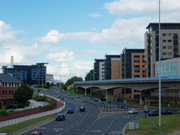
The A57 and A61 roads are the major trunk roads through Sheffield. These run east–west and north–south respectively, crossing in the city centre, from where the other major roads generally radiate spoke-like. An inner ring road, mostly constructed in the 1970s and extended in 2007 to form a complete ring, allows traffic to avoid the city centre, and an outer ring road runs to the east, south east and north, nearer the edge of the city, but does not serve the western side of Sheffield.
Sheffield does not have as extensive a suburban and inter-urban railway network as other comparable British cities. However, there are several local rail routes running along the city's valleys and beyond, connecting it with other parts of South Yorkshire, West Yorkshire, Nottinghamshire, Lincolnshire and Derbyshire. These local routes include the Penistone Line, the Dearne Valley Line, the Hope Valley Line, and the Hallam Line. As well as the main stations of Sheffield and Meadowhall, there are four suburban stations, at Chapeltown, Darnall, Woodhouse, and Dore.
A light rail system, currently operated by Stagecoach Supertram opened in 1994, shortly after the similar Metrolink scheme in Manchester. Its network consists of 37 miles (60 km) of track and three lines, from Halfway to Malin Bridge (Blue Line), from Meadowhall to Middlewood (Yellow Line), and from Meadowhall to Herdings Park (Purple Line), with all three lines running via the city centre. The system runs on both roads and train tracks, depending upon the section and line. The supertram serves as an important connection between areas in the North East of Sheffield (namely Meadowhall and Valley Centertainment) and the city centre. Because it is operated by the Stagecoach Group, the ticketing system for the Supertram is integrated with Stagecoach buses in Sheffield, meaning passengers can switch between the two modes of transport without having to buy a separate ticket.
Sheffield's local bus infrastructure has its main hub at Sheffield Interchange. Other bus stations lie at Halfway, Hillsborough and Meadowhall. A flurry of new operators were created after deregulation in 1986, though a series of mergers has reduced the number.
There are numerous bus operators within Sheffield: First, Stagecoach, TM Travel, Hulleys of Baslow, Powell's Co, K&H Doyle and Sheffield Community Transport. First South Yorkshire, part of FirstGroup, became by far the largest bus operator and in recent years implemented a series of fare rises and service cuts which saw bus ridership drop. Recent developments have seen Stagecoach Sheffield taking over Yorkshire Terrier, Andrews and parent company Yorkshire Traction, thus forming one company and in the process expanding their bus services in the city. This has resulted in increased competition, and price drops on certain routes. A zero-fare bus service—the FreeBee—operates on a circular route around the city centre from the Sheffield Interchange.
In 2008, the Bus Rapid Transit Scheme between Sheffield and Rotherham was approved by the Yorkshire and Humber Assembly's Regional Transport Board. There are plans for two routes; one (the Northern route) via Meadowhall and Templeborough, and the other via the developing employment centre and Waverley.
For cycling, although hilly, Sheffield is compact and has few major trunk roads. It is on the Trans-Pennine Trail, a National Cycle Network route running from Southport in the north-west to Hornsea in the East Riding.
Education
Universities and colleges
Sheffield has two universities, the University of Sheffield and Sheffield Hallam University. The two combined bring about 54,000 students to the city every year. Sheffield University was established in 1897 as University College Sheffield and became the University of Sheffield in 1905. The University is now ranked 40th in the world and 20th in Europe. The university is a leading member of the Russell Group and has produced five Nobel Prize winners. Sheffield Hallam University's history goes back to 1834 with the establishment of the Sheffield School of Design. During the 1960s several independent colleges (including the School of Design) joined to become Sheffield Polytechnic (Sheffield City Polytechnic from 1976) and was finally renamed Sheffield Hallam University in 1992. Sheffield Hallam University is the eighth largest university in the UK in terms of enrolment. Robert Winston, the well known physician, politician and TV presenter, is the Chancellor of the university.
Sheffield has two further education colleges, The Sheffield College and Longley Park Sixth Form College. The Sheffield College is organised on a federal basis and was originally created from the merger of six colleges around the city, since reduced to just four: Sheffield City (formerly Castle) near the city centre, Hillsborough, serving the north of the city and Norton and Peaks to the south.
Secondary, Primary and Pre-School education
There are 137 primary schools, 25 secondary schools—of which 8 have sixth forms ( High Storrs, King Ecgberts, King Edward VII, Silverdale, Meadowhead, and Tapton, Notre Dame Catholic High & All Saints Catholic High)—and a sixth-form college, Longley Park Sixth Form College. The city's five independent private schools include Birkdale School and the Sheffield High School for Girls. There are three academies in the City – Sheffield Springs Academy, Sheffield Park Academy and Parkwood Academy There are also 12 Special schools and a number of Integrated Resource Units in mainstream schools which are, along with all other schools, managed by Sheffield City Council. All schools are non-selective, mixed sex schools. The Early Years Education and Childcare Service of Sheffield City Council manages 32 nurseries and children's centres in the city.
Sport
Sheffield has a long sporting heritage. In 1857 a collective of cricketers formed the world's first-ever official football club, Sheffield F.C., and the world's second-ever, Hallam F.C., who also play at the world's oldest football ground in the suburb of Crosspool. By 1860 there were 15 football clubs in Sheffield, with the first ever amateur league and cup competitions taking place in the city. There are two professional clubs in the Football League: Sheffield United and Sheffield Wednesday. Sheffield United play in the Football League Championship and Sheffield Wednesday in Football League One. Rotherham United, who play in Football League Two, also play their home games in the city as of 2010, having moved to play at Sheffield's Don Valley Stadium in 2008 following a dispute with their previous landlord at their traditional home ground of Millmoor, Rotherham. There are also two major non-league sides: Sheffield F.C. and Hallam F.C., although Sheffield now play just outside the city in nearby Dronfield. Sheffield and Hallam contest what has become known as the Sheffield derby, whilst United and Wednesday contest the Steel City derby. There are also facilities for golf, climbing, and bowling, as well as a newly inaugurated national ice-skating arena ( IceSheffield).
Sheffield is also home to the Sheffield Steelers ice hockey team who play out of the 8,500 seater Sheffield Arena. They play in the 10 team professional Elite Ice Hockey League. Many of Sheffield's sporting facilities were built for the World Student Games, which the city hosted in 1991. They include the Don Valley International Athletics Stadium, the largest athletics stadium in the UK with a capacity of 25,000, Sheffield Arena, and the Ponds Forge international diving and swimming complex. Ponds Forge is also the home of Sheffield City Swimming Club, a local swimming club competing in the speedo league. The Sheffield Ski Village is the largest artificial ski resort in Europe. The city also has three indoor climbing centres. Sheffield was the UK's first National City of Sport and is now home to the English Institute of Sport.
Sheffield also has close ties with snooker, with the city's Crucible Theatre being the venue for the World Snooker Championships. The English Institute of Sport hosts most of the top fencing competitions each year, including the National Championships for Seniors, Juniors (U20's) and Cadets (U17's) as well as the 2011 Senior European Fencing Championships. The English squash open is also held in the city every year. The International Open and World Matchplay Championship bowls tournaments have both been held at Ponds Forge. The city also hosts the Sheffield Eagles rugby league, Sheffield Tigers rugby union, Sheffield Sharks basketball, Sheffield University Bankers hockey, Sheffield Steelers ice hockey and Sheffield Tigers speedway teams.
Sheffield was selected as a candidate host city by the English Football Association (FA) as part of the English 2018 and 2022 FIFA World Cup bid on 16 December 2009. Hillsborough Stadium was chosen as the proposed venue for matches in Sheffield.
Culture and attractions
Sheffield made the shortlist for the first city to be designated UK City of Culture, but in July 2010 it was announced that Derry had been selected.
Attractions
The Sheffield Walk of Fame in the City Centre honours famous Sheffield residents past and present in a similar way to the Hollywood version. Sheffield also had its own Ferris Wheel known as the Wheel of Sheffield, located atop Fargate shopping precinct. The Wheel was dismantled in October 2010 and moved to London's Hyde Park. Heeley City Farm and Graves Park are home to Sheffield’s two farm animal collections, both of which are fully open to the public.
There are about 1,100 listed buildings in Sheffield (including the whole of the Sheffield postal district). Of these, only five are Grade I listed. Fifty-nine are Grade II*, but the overwhelming majority are listed as Grade II. Compared to other English cities, Sheffield has few buildings with the highest Grade I listing—Liverpool, for example, has 26 Grade I listed buildings. This situation led the noted architecture historian Nikolaus Pevsner, writing in 1959, to comment that the city was "architecturally a miserable disappointment", with no pre-19th century buildings of any distinction. By contrast, in November 2007, Sheffield's Peace and Winter Gardens beat London's South Bank to gain the Royal Institute of British Architects' Academy of Urbanism "Great Place" Award, as an "outstanding example of how cities can be improved, to make urban spaces as attractive and accessible as possible".
Music
Sheffield has been the home of several well-known bands and musicians, with an unusually large number of synth pop and other electronic outfits originating from the city. These include The Human League, Heaven 17, ABC, and the more industrially inclined Cabaret Voltaire. This electronic tradition has continued: techno label Warp Records was a central pillar of the Yorkshire Bleeps and Bass scene of the early 1990s, and has gone on to become one of Britain's oldest and best-loved dance music labels. More recently, other popular genres of electronic music such as bassline house have originated in the city. Sheffield is home to a number of high-profile nightclubs— Gatecrasher One was one of the most popular nightclubs in the north of England until its destruction by fire on 18 June 2007.
Artists such as Pulp, Def Leppard, Joe Cocker, Paul Carrack, Richard Hawley, The Longpigs, Milburn, Moloko, and Bring Me the Horizon, along with many other popular and alternative musicians, were born in Sheffield. More recently several indie bands, including Arctic Monkeys, The Long Blondes and Toddla T have emerged from the city as part of what the NME dubbed the New Yorkshire movement.
In 1999, the National Centre for Popular Music, a museum dedicated to the subject of popular music, was opened in the city. It was not as successful as was hoped, however, and later evolved to become a live music venue; then in February 2005, the unusual steel-covered building became the students' union for Sheffield Hallam University. Live music venues in the city include the Harley Hotel, Leadmill, West Street Live, the Boardwalk, Dove & Rainbow, The Casbah, The Cremorne, Corporation, New Barrack Tavern, The Broadfield Hotel, the City Hall, the University of Sheffield, the Studio Theatre at the Crucible Theatre, the O2 Academy Sheffield, and The Grapes.
Sheffield hosts a number of festivals, most notably the Grin Up North Sheffield Comedy Festival, and the Tramlines Festival. The Tramlines Festival was launched as an annual music festival in 2009, it is held throughout venues in Sheffield City Centre, and features local and national artists. The city is also home to several local orchestras and choirs, such as the Sheffield Symphony Orchestra, the Sheffield Philharmonic Orchestra, the Sheffield Chamber Orchestra, the City of Sheffield Youth Orchestra, and the Sheffield Philharmonic Chorus.
Theatres
Sheffield has two large theatres, the Lyceum Theatre and the Crucible Theatre, which together with the smaller Studio Theatre make up the largest theatre complex outside London, located in Tudor Square. The Crucible theatre is the home (since 1977) of the world snooker championships and hosts many well known stage productions throughout the year. The Lyceum, which opened in 1897, serves as a venue for touring West End productions and operas by Opera North, as well as locally produced shows. Sheffield also has the Montgomery Theatre, a small 420 seater theatre located a short distance from Tudor Square, opposite the town Hall on Surrey Street.
Museums
Sheffield’s museums are managed by two distinct organisations. Museums Sheffield manages the Weston Park Museum (a Grade II* listed Building), Millennium Galleries, Graves Art Gallery and Bishops House (a preserved Tudor building located to the south of the city centre). Sheffield Industrial Museums Trust manages the museums dedicated to Sheffield’s industrial heritage of which there are three. Kelham Island Museum (located just to the North of the city centre) showcases the citys history of steel manufacturing. Abbeydale Industrial Hamlet (in the south of the city) is a Grade 1 Listed building and a Scheduled Ancient Monument. Shepherd Wheel (in the south-East of the city) is a former water-powered grinding workshop, Grade II listed, and a Scheduled Ancient Monument.
Greenspace
Sheffield has a reputed 2 million trees and is known as the greenest city in Europe. Consequently, there are many parks and woods throughout the city and beyond. There are 83 parks in Sheffield (13 ‘City’ Parks, 20 ‘District’ Parks and 50 ‘Local’ Parks) which are located throughout the city. Included in the city parks category are 3 of Sheffield’s 4 public gardens (The Sheffield Botanical Gardens, The Peace Gardens and Hillsborough Walled Gardens, with the Sheffield Winter Gardenss being the separate entity). The Sheffield Botanical Gardens are on a 19 acresite located to the south west of the city centre and date back to 1836. The site includes a large, Grade II listed, Victorian era glasshouse. The Peace Gardens, located adjcant to the Town Hall and forming part of the Heart of the City project, occupy a 0.67 hectare site in the centre of the city. The site is dominated by its water features, principle among which is the Goodwin Fountain. Made up of 89 individual jets of water, this fountain lies at the corner of the quarter-circle shaped Peace Gardens and is named after a notable Sheffield industrialist. Since their redevelopment in 1998, the peace gardens have received a number of regional and national accolades. Hillsborough Walled Garden is located in Hillsborough Park, to the north west of the city centre. The gardens date back to 1779 and have been dedicated to the victims of the Hillsborough Disaster since the redevelopment of the gardens in the early 1990s. The Winter Garden, lying within the Heart of the City, is a large wood framed, glass skinned greenhouse housing some 2,500 plants from around the world.
Also within the city there are a number of nature reserves which when combined occupy 1,600 acres (6.5 km2) of land. There are also 170 woodland areas within the city, 80 of which are classed as ancient.
The South East boundary of the city overlaps with the Peak District National Park, the first national park in England (est. 1951). As a consequence, several communities actually reside within both entities. The Peak District is home to many notable, natural, features and also man-made features such as Chatsworth House, the setting for the BBC series Pride and Prejudice.
In September 2010 Sheffield City Council announced plans to create a new chain of parks spanning the hill side behind Sheffield Station. The park, known as Sheaf Valley Park, will include an arboretum and an open air amphitheatre. The site was once home to a medieval Deer park, latterly owned by the Duke of Norfolk.
Entertainment
Sheffield has four cinema complexs, 2 of which are in the city centre and 2 in the Lower Don Valley. Valley Centertainment is a leisure and entertainment complex in the Don Valley. It was built on land previously occupied by steel mills near what is now Meadowhall and the Sheffield Arena. It is home to several restaurants, bars, a cinema multiplex, and a bowling alley. It is also the largest cinema complex in the United Kingdom, containing some 20 screens in one building. The Odeon, situated on Arundel Gate in the city Centre and Vue, located within Meadowhall Shopping Centre, are the two other mainstream cinemas in the city. The Showroom, an independent cinema showing non-mainstream productions, is located in Sheaf Square, close to Sheffield Station. In 2002 the Showroom was voted as the best Independent cinema in the country by Guardian readers
Owing to its long history, Sheffield has a large number of pubs throughout the city. The oldest pub in the city is the Old Queen's Head situated next to Sheffield Interchange, which is said to be the oldest domestic building in the city, dating back to 1475. West Street, running through the heart of the West End district of the city centre, is home to many pubs, bars, bars and clubs and attracts many student visitors. A recent addition to the city's nightlife is Leopold Square, situated just off the northern end of West Street. Aagrah, an Indian restaurant in the square which serving Kashmiri cuisine, has recently been voted “Best Restaurant Group in the UK” at the prestigious British Curry Awards.
Public services
Sheffield is policed by South Yorkshire Police (a territorial police force) whose headquarters are in the city. Sheffield constitutes one of its four Basic Command Units (Barnsley, Doncaster and Rotherham being the other three). The force polices an area of approximately 1,554 square kilometres and is the 13th largest force in England, Wales and Northern Ireland. The force has in its possession one Police Helicopter, known as Sierra Yankee 99.
Medical services in Sheffield are provided by two NHS Foundation Trusts. Sheffield Teaching Hospitals NHS Foundation Trust provides healthcare to people (primarily adults) throughout Sheffield and South Yorkshire. The trusts title includes the word ‘teaching’ because it undertakes training of medical students at the University of Sheffield and has strong links to Sheffield Hallam University as well. The trust has two campuses: The West Campus containing the Royal Hallamshire Hospital, the Jessop Wing (maternity wing), Weston Park Hospital (specialist cancer treatment) and Charles Clifford Dental Hospital. The Northern General Hospital is the second ‘campus’ and is a large faciliy in the northern suburbs of Sheffield, containing the city’s A&E department. Sheffield Children's NHS Foundation Trust provides healthcare for children within the city of Sheffield, South Yorkshire and the UK as a whole.
On the 18th November 2010, Her Majesty Queen Elizabeth II inaugurated the Sheffield Institute for Motor Neurone Disease (also known as Sheffield Institute for Translational Neuroscience – SITraN), a unique, world-class facility that has been developed by the University of Sheffield.
Ambulances are provided by the South Yorkshire Ambulance Service, which itself is an NHS trust.
Fire services in Sheffield are provided by South Yorkshire Fire and Rescue Service. For the purposes of fire-fighting and rescue, Sheffield is divived into East and West sub-divisions.
Sister Cities
The "Sheffield International Linking Committee" promotes Sheffield overseas, especially with four sister cities:
A further four cities have a Friendship Agreement with Sheffield:
 Kawasaki, Japan
Kawasaki, Japan Kitwe, Zambia
Kitwe, Zambia Kotli, Kashmir, Pakistan
Kotli, Kashmir, Pakistan Pittsburgh, United States
Pittsburgh, United States
Two roads in Sheffield have been named after sister cities; a section of the A6102 in Norton is named Bochum Parkway, and a road in Hackenthorpe is named Donetsk Way.


